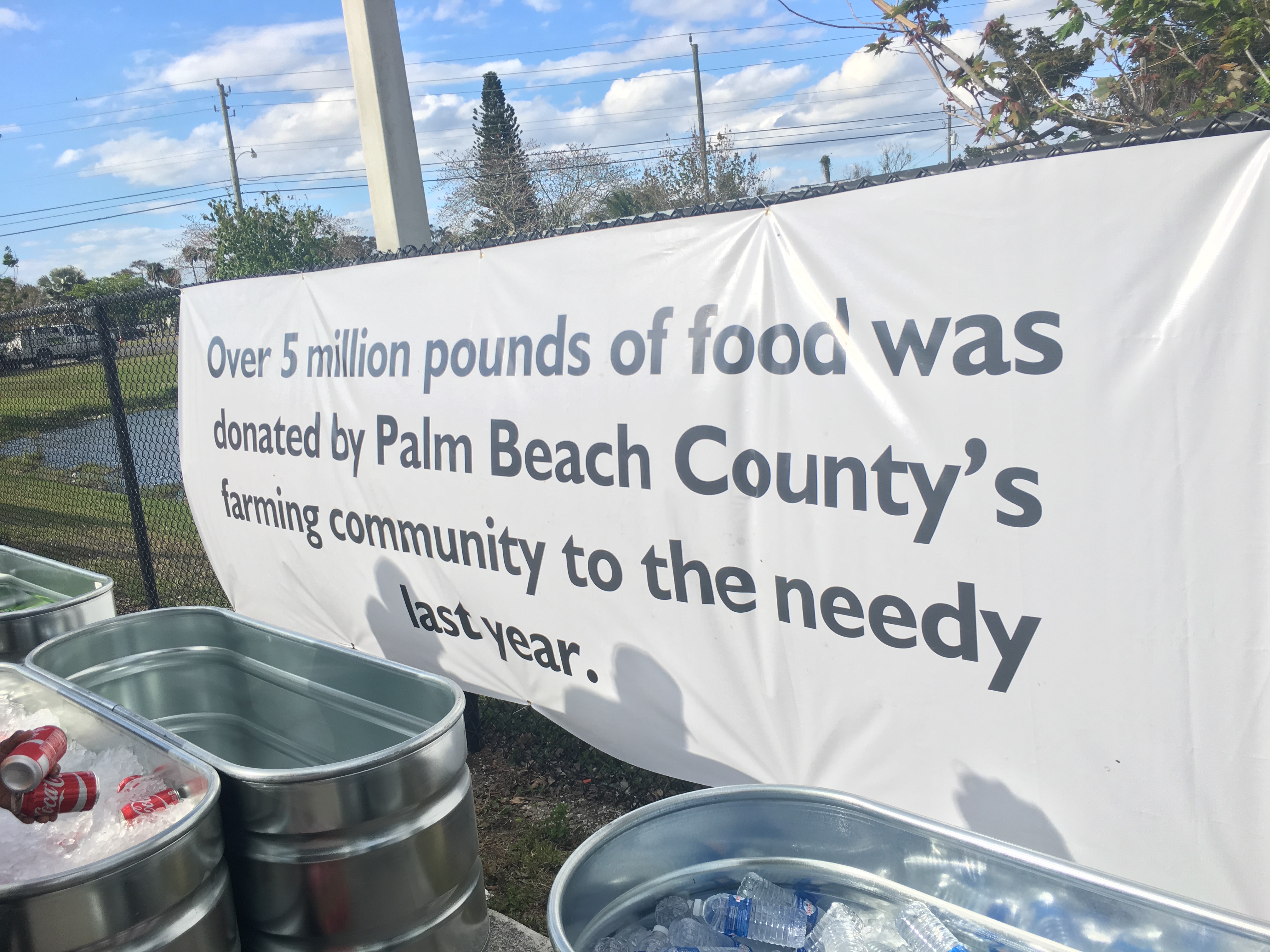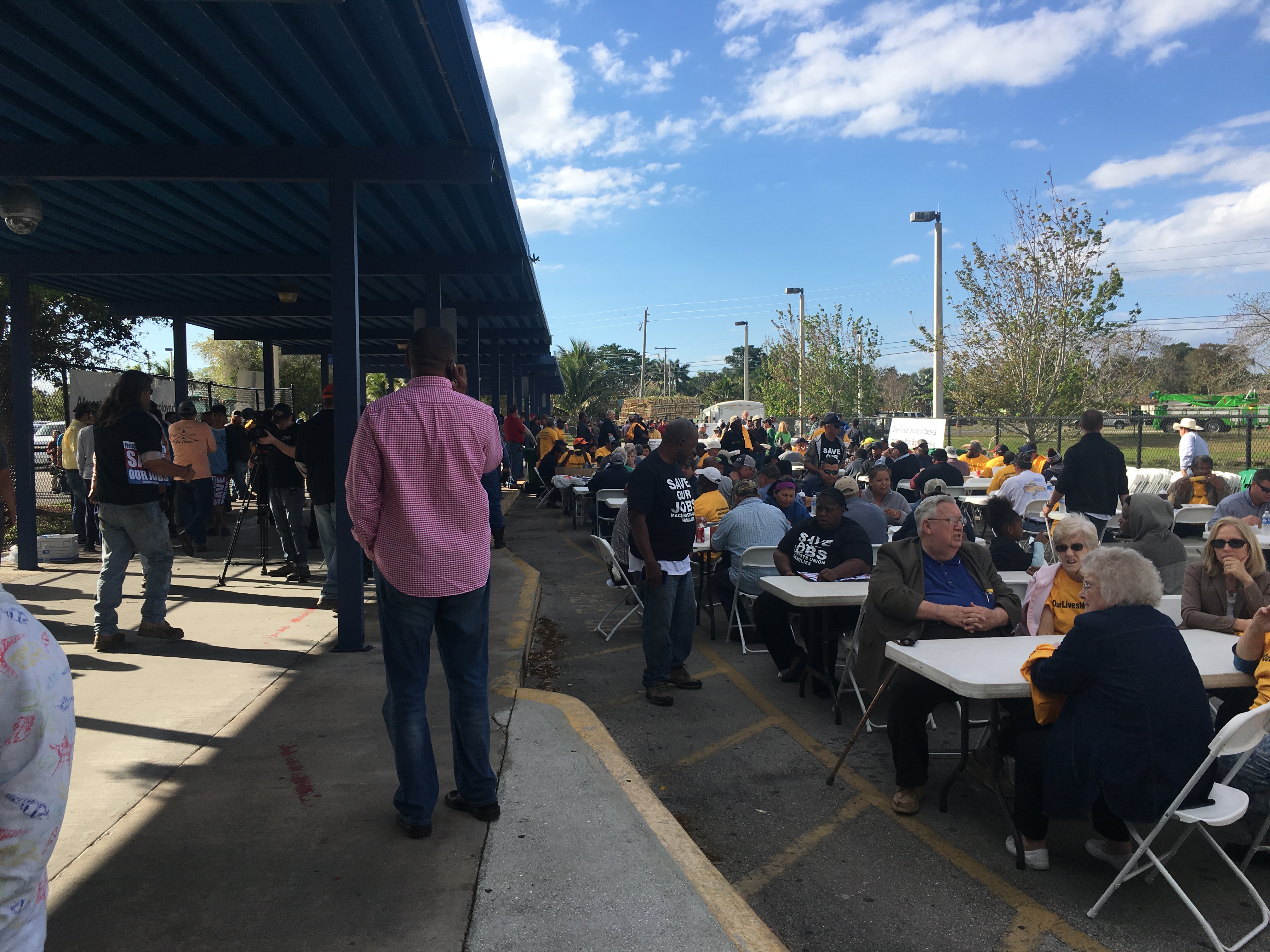On Friday, March 17, residents and other concerned parties in the Glades Region of Palm Beach County attended a public forum about the proposed plan to use Glades farmland for flooding. The BDB-LORE Alliance continues to work with local, county, and state-level counterparts to help preserve the Glades Region land and jobs.
Here’s a couple of photos that BDB VP of the Glades Region Luke Jackson captured at the forum:


PALM BEACH POST ARTICLE:
In a face-off Friday night at Pahokee High School, hundreds of Glades area residents came out in force to tell Florida Senate President Joe Negron his proposal to build a 60,000-acre reservoir on farmland south of Lake Okeechobee would kill jobs and economically devastate their rural communities.
Dozens of machinists union members wore black T-shirts emblazoned with “Save our Jobs” in white letters. Sugar cane and vegetable farmers bore green-and-white “Stop the land grab,” and “Hands off my tractor,” signs. Others hung toilet seats around their necks, stating, “Clean up your own septic mess,” a reference to the estimated 250,000 to 600,000 septic tanks draining into Lake Okeechobee from the north.
The auditorium was filled to its capacity of 400, and several hundred people who quietly waited outside were turned away. Police estimated the total number of people who turned out at 1,000.
“We cannot, do not and will not support SB 10 as it is today,” said Lynda Moss, a Pahokee resident whose family owns and operates Moss Towing and Trucking in South Bay. “The devastation from the loss of jobs is unimaginable at this point.”
Years ago, farmers were mandated to clean up Lake Okeechobee and have exceeded their goals, Moss said.
“We feel it is time for the coastal communities to take accountability for what they’ve done and take accountability for the water,” Moss said, adding that a retention area is needed at the north end of the lake.
Moss called the Glades “God’s Country,” and she and others expressed pride in being the nation’s winter vegetable producing leader, a position they say a land buy would topple.
Clewiston resident Janet Taylor, a Hendry County commissioner and a leader of Glades Lives Matter, told Negron, “Mr. President, please don’t make this issue about saving one area of your district at the expense of another.”
Senate Bill 10, now called the “Coast-to-Coast Comprehensive Water Resource Program,” began as a $2.4 billion proposal to acquire between 60,000 and 153,000 acres of prime sugar cane and vegetable-growing land, largely in western Palm Beach County. An identical bill has been filed in the Florida House, HB 761.
The proposal has now been expanded to include water projects related to the St. John’s River, the Indian River Lagoon and the Florida Keys, and the estimated cost has grown to $3.3 billion.
Negron, R-Palm City, and Sen. Rob Bradley, R-Fleming Island, contend that reservoirs south of Lake O will help solve pollution and toxic-algae problems in the St. Lucie and Caloosahatchee estuaries. Algae ended up on beaches in Martin and Palm Beach counties ahead of the July 4 weekend last summer.
Pahokee Mayor Keith Babb, Pahokee City Manager Chandler Williamson, and Palm Beach County Commissioner Melissa McKinlay sat on the panel with Negron, whose district now includes Pahokee.
Negron said he was there to try to understand the legitimate economic concerns of the residents of Pahokee, Belle Glade, Clewiston, Canal Point and the entire Glades area.
Residents submitted dozens of written questions. Most of the questions were directed at Negron and asked why he feels the project is needed, and whether it will work. They asked how they as individuals and as a community will survive if the land is taken out of production, and they lose their jobs and homes and cherished way of life.
Negron said he hopes to come up with a plan that doesn’t adversely affect jobs.
By one estimate, job losses would total 4,100 in agriculture and other businesses sustained by it.
Land the state owns and land owned by private owners who are not in the sugar industry, as well as land swaps, are being considered, Negron said. He said that by the end of the legislative session in May, he expects to have a combination of public and privately held land cobbled together that could be purchased to build a water reservoir south of the lake.
Negron said he wants a solution to Lake O discharges and to make sure every community is doing its fair share, which is why he has supported fertilizer ordinances.
“But for me, it’s unsustainable, long-term, to have situation that when the lake gets to 16 feet, we are just going open up flood gates and have discharges hundreds of billions of gallons of water east and west,” Negron said.
State Rep. Rick Roth, R-Wellington, who is a Belle Glade farmer, asked Negron what would happen if no willing sellers are found. Glades-area farmers and landowners have said they will not sell their land.
Negron said he disagrees that there no willing sellers, and said there are some who are “in discussions with us.”
More storage to the south and north of the lake would solve 80 percent of the problem, Negron added. “We all need to come together and come up with something that will work for everyone,” he said.
The U.S. Army Corps of Engineers controls Lake Okeechobee, and state and local governments cannot tell it what to do, Negron said. He asserted that if the Corps had kept the lake one foot deeper last year, discharges into the St. Lucie River would not have occurred.
A lake that’s too full should also be a flood concern for Pahokee and the Glades, Negron said, reminding the crowd of the 1928 hurricane when a wall of water killed more than 2,000 people western Palm Beach County.
McKinlay, who opposes the land buy, said the ripple effect of taking the land out of agricultural production would touch all aspects of the community. She said that there are 5.5 million acres of publicly owned lands south of the lake.
Restoration projects already approved should be completed before a new one is contemplated, McKinlay said.
Babb said the community doesn’t oppose storing water, but it is against storing water on productive agricultural land. He agreed that the state needs to use the 120,000 acres it has already purchased for Everglades restoration first.
With an unemployment rate at 25 percent, the Glades cannot afford to lose any jobs and need more economic development, Babb said.
The Everglades Foundation, Everglades Trust and other environmental groups support buying land south of the lake for storage and favor reducing discharges to the St. Lucie and Caloosahatchee estuaries.
Over the past 20 years, farmers have given up nearly 120,000 acres for stormwater-treatment areas.
After the meeting, several community leaders said while they appreciated Negron’s visit, they feel that Negron’s mind was already made up.
“It’s unfortunate that Senator Negron still continues to push for this misguided land grab,” said John Scott Hundley of EAA Farmers.
Said Robert Miller, a representative of the Machinist Union: “It’s sad that President Negron refuses to change his mind on this job-killing bill so that our jobs and our communities will not be harmed.”
This article is from the Palm Beach Post: full article here

